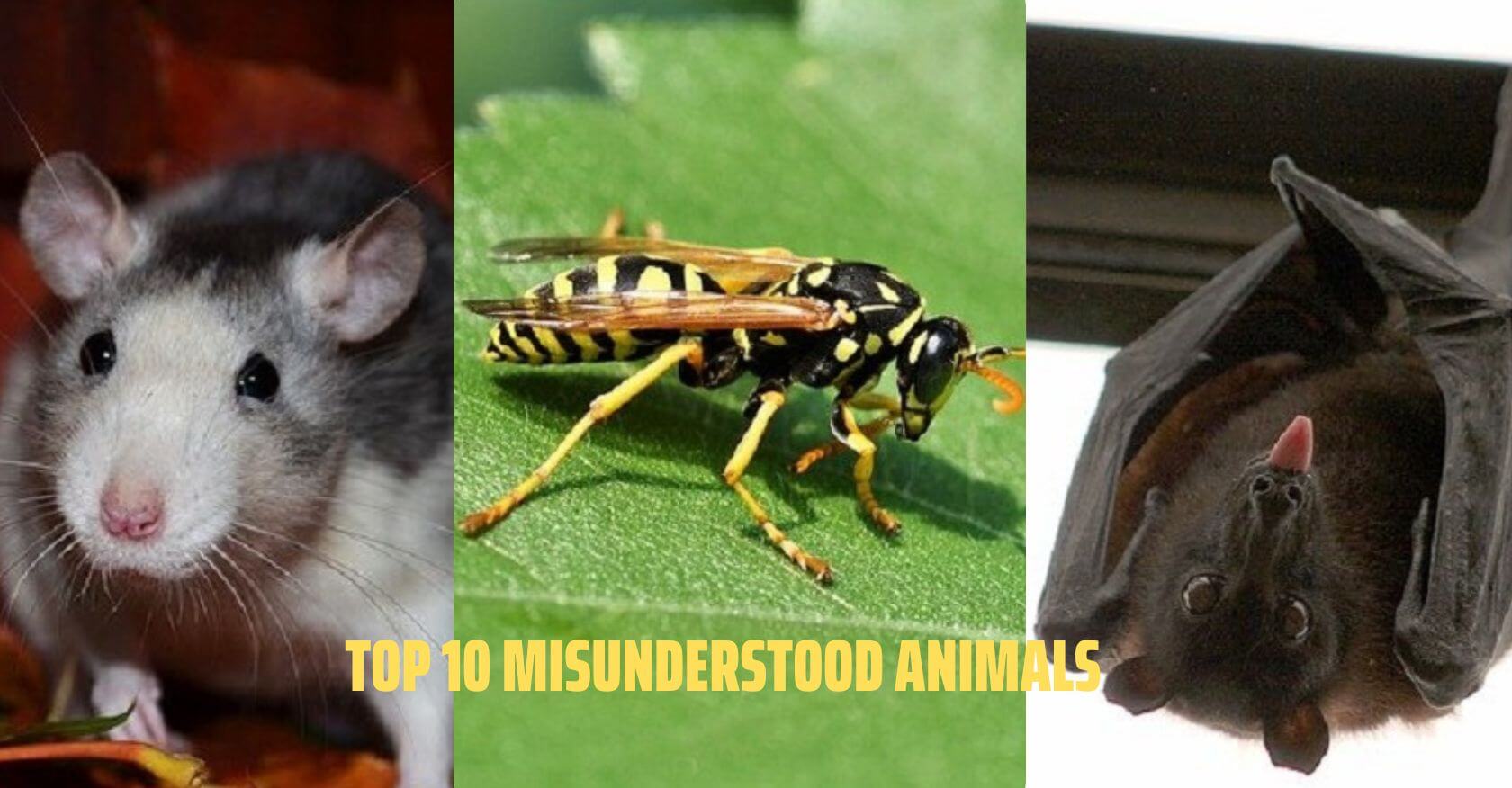Humans so often misunderstand some animals, regarding them as dangerous, frightening, disgusting, dirty, ‘pests’ or ‘vermin’. They fear them and very often go out of our way to kill them because they don't like the way they look or feel or are put off by films or folklore. So often though, it's a misguided opinion. Many are harmless to humans and they all have a part to play in maintaining the habitat around them. They are an important part of our ecosystem.
10. Snake
Ophidiophobia, more often known as a fear of snakes, is extremely common. The media show them in a negative light and from an evolutionary perspective, it makes sense to fear something that can hurt us. But did you know only around 600 are venomous and that of those, only 200 can prove fatal or cause serious injury to humans? That’s about 7%! The majority are harmless.
Furthermore, snakes rarely attack unprovoked. Venom takes time and energy to make so is it not something they want to give up unnecessarily, and we are not their prey. If left alone, they have no need to waste it on us. It is when they feel threatened they attack, and even then, it is usually a last resort, and they will likely attempt to flee first. They may also offer a warning first, such as rattling their tail or rubbing their scales together to produce a rasping sound.
Why we love snakes
Snakes make up a significant proportion of the middle-order predators that keep our natural ecosystems working. Without them, the numbers of prey species would increase to unnatural levels, and the predators that eat snakes would struggle to find food.

9. Alligators
As groups of animals go, reptiles are some of the most misunderstood, and, as alligators top the group as some of the largest, it is not surprising they have made it to this list. The truth is though, their reputation as man-eaters isn’t strictly warranted; they don’t normally pursue humans as prey as they are too big. Most attacks occur because people have fed them or because they are defending their nests from people who have wandered into their territory.
They are, however, large and territorial and predators that feast on whatever suitable prey is accessible at the time. For that reason, they deserve our respect and understanding. One of the biggest issues occurs because people feed alligators, encouraging them to get close to humans and to become a serious threat to public safety. Alligators, or their nests, should never be approached and people should avoid becoming complacent in and around water bodies where they live.
Why we love alligators
Alligators are an important part of natural history as well as an integral component of freshwater ecosystems. Some species are considered critical for the way they modify their habitat, for instance, American alligators living in the Everglades dig “gator holes”, which are often the only aquatic habitat left during the dry season, providing an important refuge for many species of fish, turtle and other aquatic species, as well as a source of water for birds, terrestrial animals and plants.

8. Wasp
If there is one insect that has people running around in a flap, waving their arms and screeching in fear, it’s the wasp. They are unlikely to sting for no reason, though; stinging is a defensive mechanism they turn to when disturbed or feeling under threat, for example from waving arms and legs. Stay still, let them be, and you will likely be fine. If you do get stung, adverse reactions are unusual, with most people experiencing mild pain, redness, minor swelling and itching. Only about 10% of people have adverse reactions to wasp stings, and deaths from stings are extremely rare.
Why we love wasps
In the natural world, wasps have their role to play; like bees, they are a beneficial insect that pollinates plants and flowers as they feed on nectar. They also prey on other insects helping to keep those populations under control. They are a natural pesticide, without which we would need more chemicals to control pests and protect our vegetable patches.

7. Slugs
Slugs have a reputation for being horrible, slimy garden pests that eat their way through garden plants. Beer, salt, copper tape and poisonous commercial pellets are all used frequently to eradicate the creatures, but, like all other creepy crawlies, slugs play a role in maintaining a healthy ecosystem, and they are truly fascinating creatures. For example, did you know they have 27,000 teeth?
Why we love slugs
Slugs do eat valuable plants, but they also composters. They consume vast quantities of decaying vegetation, dead leaves and animal droppings, and in the process, return essential nutrients to the soil. They are also a source of food for other wildlife including mammals, birds, slow worms, earthworms and insects. They are part of the natural balance.

6. Rats
Musophobia is the fear of mice and rats. It is extremely common, perhaps because of their ability to carry diseases (a flea common to rats has often been blamed for the plagues of the Middle Ages), or because of their long, wormlike tails. Or maybe it’s because movies like to portray them as ‘vicious’ or ‘evil’. Whatever the reason, they have a bad reputation they don’t deserve.
Rats are highly intelligent, social, affectionate animals that enjoy the company of other rats. They are also extremely clean and docile animals that prefer to run away rather than confront a potential threat, and that includes people. They will only attack if provoked or cornered, as many wild animals do.
Why we love rats
Rats make fabulous companion animals. They are clean, easy to train and form strong bonds with humans, returning as much affection as they get.

5. Bats
Vampires in stories and films are often portrayed as being able to transform into bats. This, and the widespread misconception that all bats feed on blood, explains why many people fear them, as does the idea that they spread rabies. In fact, only three species actually feed on blood, the rest feed on insects or fruit, and only 0.5% of vampire bats actually carry rabies. They are no more likely to catch it than any other mammal. They are not immune, either. Since they are so small, the disease kills them quickly, and they rarely become aggressive and spread the disease.
Bats also flee rather attack people. More injuries occur because of people’s frenzied reactions to their swooping for insects than from bats themselves!
Why we love bats
Bats play a significant role in controlling insect populations. According to the Bat Conservation International website, a single brown bat can eat up to 1,000 mosquito-sized insects in a single hour! Bats foraging around macadamia farms have been found eating stinkbugs – a major agricultural pest – and Mexican free-tailed bats primarily eat corn ear worms and cotton bollworm moths, which are agricultural pest species that cause millions of dollars in damage to crops each year!
Fruit and nectar-feeding bats pollinate many plants and foods such as bananas, peaches, guavas, mangoes, avocado, figs, dates, papaya, almonds, cashew nuts, vanilla and other products such as tequila (from the agave plant), carob and more.

4. Jellyfish
Jellyfish are well known for their stinging tentacles and ability to hurt us even when dead, but this reputation is due only to a small number of the 2000+ types of jellyfish that exist. Most species are harmless to humans or only have a mild sting and they do not intentionally attack humans. They have very little ability to push themselves along in the water and mostly drift along with currents. Interactions are accidental; if you see one, swim away!
Some other common-sense measures can be taken to avoid jellyfish stings; on beaches lookout for flags warning that there are jellyfish in the water. Jellyfish will often get washed up on the shore; make sure you or your children, don’t touch them.
Why we love jellyfish
Jellyfish play an important role in the food chain and help maintain balance in the delicate ocean ecosystem. Small jellyfish eat little organisms, like algae and tiny zooplankton, while larger species feast on bigger animals. By eating other sea life, jellyfish help to control the population of these creatures and maintain a healthy balance.
Jellyfish faeces also sink to the seafloor where they fertilize plants and feed tiny sea creatures. Jellyfish are also a food source themselves, providing food for sea turtles, sunfish and spadefish, crabs and other large crustaceans.

3. Gulls
Seagull is a name commonly used to describe species of gull within the Family Laridae; there are over 50 species worldwide. They are intelligent, beautiful birds that are at home at the seaside. In recent years though, they have got themselves a bad reputation, with many considering them to be a noisy, messy, food-stealing nuisance.
There are many reasons why seagulls are stealing food from people and becoming a ‘nuisance’, and all of them are linked to humans! There is a change in natural food due to destructive fishing methods destroying the environment and reducing food availability. With more people visiting the seaside and enjoying delights such as fish and chips, ice cream and other snacks, there is more food available onshore. People don’t always dispose of leftovers properly either and leavee scraps lying around and bins overflowing. It’s easy-pickings for hungry seagulls that are not only clever enough to learn new skills but also pass them on to others.
Why we love seagulls
Seagulls are fascinating birds that are adapting to a make the most of life around humans, learning new methods of finding food – whether we like it or not – and passing what they know onto young. They are faithful and mate for life with both male and females pitching in to look after their chicks.
They are also an essential part of the marine ecosystem, controlling prey numbers offshore and redistributing nutrients in their guano (poo) which is full nutrients and an extremely effective fertiliser.

2. Sharks
Sharks have a reputation for being man-eaters. Their huge size, ferocious appearance and sharp teeth scare people, and their fame from movies like Jaws really doesn’t help matters. Shark encounters do indeed occur, and the media loves to sensationalist them, but they are rare and, statistically, sharks pose very little threat to humans. This is especially true if you understand and respect their natural behaviours and instincts.
Sharks are wild animals that don’t naturally prey on humans. When attacks do occur, they are generally out of curiosity. They are investigating what is splashing in their environment, seeing whether or not it is food rather than deliberately hunting. If you are in shark habitat, there is a risk of coming into contact with them, but you can reduce the likelihood by taking a few simple precautions. For example, always stay in groups, avoid being in the water during darkness or twilight hours when sharks are most active and avoid wearing shiny jewellry that can resemble the sheen of fish scales.
Why we love sharks
Sharks are at the top of the food chain in virtually every part of every ocean. In that role, they keep populations of other fish healthy and in proper proportion for their ecosystem. They tend to eat very efficiently, going after the old, sick, or slower fish in a population that they prey upon. Some also scavenge the seafloor to feed on dead carcasses. Scientists consider them to be ‘keystone’ species, meaning that removing them would cause the whole structure to collapse!

1. Spiders
Arachnophobia, the fear of spiders. It is extremely common and perhaps understandable given their unusual appearance and number of legs. They enter homes and some bite and have the ability to harm or even kill humans. But that is the minority. There are around 40,00 different spider species in the world and only around 30 pose a risk to humans. Furthermore, they are more likely to flee humans than attack.
Why we love spiders
Spiders may not be the first on your list of house guests but perhaps they should be. They are extremely beneficial and work hard to keep the numbers of other insects, such as cockroaches, earwigs, mosquitoes, flies and clothes moths, down. And, if left alone, spiders can help limit the spread of disease carried by some of these insects.
Spiders are also a potent defence against agricultural pests like aphids, moths and beetles and they do not damage plants. They are of great value to the environment. They promote evolution by helping to keep insect numbers under control and supply food for many other animals.







